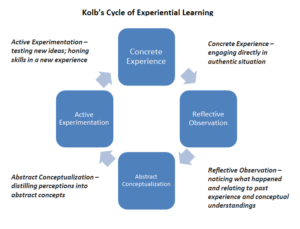What is Experiential Learning?
The easiest way to describe experiential learning is with the simple phrase, “learn by doing.” Experiential learning follows the principle that people learn best by actual practical experiences, so there is an emphasis on things such as hands-on activities, practicums, and field experiences. This theory was first proposed in the 1980’s by psychologist David Kolb, and it uses the basis that experience’s that people connect to through emotion, cognition, and the environment they were in at the time influences the learning process. Kolb (1984) created a cycle (pictured below) to better explain the thought process behind experiential learning; where concrete experience feeds into reflective observation which feeds into abstract conceptualization which feeds into active experimentation which then feeds back into finding more concrete experience to test one’s new ideas from active experimentation. The important thing to remember is that this theory is a cycle and not simply a static concept – it is a process as each component pushes forward into the next.

Experiential Learning. Boston University, n.d.
How is Experiential Learning Connected to Visual Arts?
I believe a very strong case can be made that there are many connections between visual arts and experiential learning. When the theory in question is focused on hands-on activity, and so much of art is the process of creation; the two concepts seem to go hand in hand. In early grade school, students are often given time to draw and create their own works of art, and then explain it to the class. This process is actually perfectly aligned with experiential learning, as children doing and then explaining follows Kolb’s cycle of concrete experience followed by reflective observation, and then through the comments or questions of their classmates that will lead them to more abstract conceptualization and then having new ideas to continue honing experience and so on and so forth. Creation is so closely connected to actions and doing, and art is something that does not lend itself to be taught strictly in a classroom with no opportunity to try it hands-on. Although the theory does have an emphasis on experience and the process of “doing” – reflection has equal importance in the theory, with this quote from the Association of Experiential Learning explaining, “Reflection on learning during and after one’s experiences is an integral component of the learning process. This reflection leads to analysis, critical thinking, and synthesis.” Visuals arts also places importance on reflection; as an artist must look at their work to see what they were trying to convey, how they did with making that message come across, and how they used whatever color/technique/medium to send whatever message they were trying to send. Because of this, there is a definitive link between visual arts and the way that experiential learning can and has been used to teach it.
How is Experiential Learning Connected to our Learning Resource?
My group’s learning resource is about children partaking in a collaborative mural assignment where they would use paint to create and then display their work. This concept is very much in line with what we have already established about experiential learning. The hypothetical children in this scenario are engaging in a hands-on activity of using paints to express themselves, and they must reflect and have conversations with each other as well as instructors to communicate their thoughts. They are indeed following the principle of “learn by doing” as they are in control of physically putting the paint onto the walls and explaining their process. The students would need to have an idea, plan it, and then apply it in a real-world setting and reflect on it; while instructors provide suitable support, bring up and facilitate questions, and provide resources. In the context of our learning resource, the experiential theory can be used to shape and help facilitate proper discussion in it’s connection to creation, so in that way I think it’s of immense value to incorporate elements of this learning approach into our blueprint.
Resources:
Experiential Learning By Boston University
The Experiential Learning Theory of David Kolb By Kendra Cherry, Verywellmind


Recent Comments